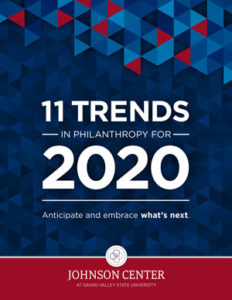Inclusive Growth Requires Urgent Collaboration and Deliberate Patience


In this piece from our 11 Trends in Philanthropy for 2020 report, Dr. Juan Olivarez stresses the importance of maintaining the momentum of inclusive growth initiatives through place-based solutions, innovative investment strategies, and systems change.
 Many philanthropic organizations have been joining forces — with their assets, competencies, and relationships — to invest in new economic opportunities and innovations, hoping to create prosperity for more people.
Many philanthropic organizations have been joining forces — with their assets, competencies, and relationships — to invest in new economic opportunities and innovations, hoping to create prosperity for more people.
These efforts have been playing out for more than a decade, through international, national, and local communities. Their focus has been on inclusive growth — a concept that promotes communities where all people share in the benefits of economic growth and increasing upward mobility, especially marginalized communities (Liu, 2017).
Today’s activities differ from past efforts in that they 1) embrace highly place-based orientations, and 2) they integrate strategies, learned over an extended period of time, that are finding success. These strategies include a heavy emphasis on collaboration among public, private, and philanthropic entities (Rubin, Blackwell, & Schildt, 2016); an innovative investment strategy (Feloni, 2018; Giloth, 2017, 2019); and a focus on systems change (Hanstad, 2019). The combination of these elements is the current trend in the journey of creating inclusive growth communities.
“Today’s activities differ from past efforts in that they 1) embrace highly place-based orientations, and 2) they integrate strategies, learned over an extended period of time, that are finding success.”
The 2019 Global Inclusive Growth (GIG) Summit, co-hosted by the MasterCard Center for Inclusive Growth and the Aspen Institute, elevated these strategies on an international stage. Around 300 attendees from a variety of public and private backgrounds gathered in Washington, D.C. in October to hear from funders and thought leaders (e.g., former Secretary of State Madeleine Albright, former New Orleans Mayor Mitch Landrieu, and Business Roundtable CEO Josh Bolten) about the continued global divide among the haves and have nots.
The summit’s stated purpose was to “catalyze new partnerships and spark new commitments” that could identify effective, scalable pathways to increasing prosperity. Some looked to the past for inspiration, while others reminded us of the current reality. Rajiv Shah, president of the Rockefeller Foundation, provided compelling data illustrating how America’s leaders once helped to build the middle class through public policies and practices, such as federal housing and the GI Bill (GIG Summit, 2019). Jean Case, CEO of the Case Foundation, discussed the effectiveness of impact investing while reminding the audience that 79% of all venture capital goes to only three states (New York, Massachusetts, California), that a mere 2% goes to women, and only 1% to persons of color (GIG Summit, 2019).
Both Shah and Case were illustrating systems-level issues and strategies at the national level. Similar conversations are also happening at the local level, where communities are convening diverse groups to explore, learn, and act in new ways to create inclusive growth. One such convening in May 2019 was the Powering Inclusion Summit in Minneapolis, Minn., hosted by the Center for Economic Inclusion. Speakers from public, private, and corporate sectors addressed the four hundred people who gathered to learn, design, and make commitments to meaningful collaborations.
New developments in the policy world are also contributing to this trend. The Opportunity Zones (OZs) designated by the 2017 Tax Cuts and Jobs Act specifically create community development-focused tax incentives that encourage collaboration and shared prosperity. “By tying the most substantial tax relief to investors who are prepared to stay for the long haul,” notes Bruce Katz (2019), “the Opportunity Zone incentive provides an enormous impetus for financiers, states, localities, and others to work together to make sure there’s a significant benefit for all involved” (para. 6). Katz goes on to encourage foundations specifically to wield their convening and financial power in the service of OZ investment.
“The Opportunity Zones designated by the 2017 Tax Cuts and Jobs Act specifically create community development-focused tax incentives that encourage collaboration and shared prosperity.”
What is clear through these examples and the larger body of literature on this subject (e.g., Katz, 2019; Sweeney, 2019; Giloth, 2017) is that the philanthropic sector can be a substantial economic driver for communities through strategies of economic inclusion. However, collaboration, long-term investments, and systems change can take a lot of time. Some funders are beginning to think about how they address this long horizon in establishing needed relationships, program design, implementation, and results.
While one report by Bridgespan indicates that the average duration of a grant made is less than 18 months, a second report indicates that systems change may take as much as 20 years (Wolf Ditkoff & Gindle, 2017). Tim Hanstad (2019), CEO of the Chandler Foundation, recently wrote in the Chronicle of Philanthropy that “in global development, where the most important social problems are complex and require structural change, we need to see fewer day traders and more long-term investors” (para. 15). Philanthropy, he argues, has to be prepared to commit to the long game.
Examples of long-term investments can be seen in efforts like the Fund for Our Economic Future, the major economic development organization in the greater Cleveland, Ohio region (Garr Pacetti, 2014). This foundation-led effort to fund and develop wealth-building programs with local anchor institutions has committed support over many years. In addition, there are promising results with Detroit’s philanthropic community which is developing new relationships and taking on roles previously left to others. Through the New Economy Initiative, the Detroit Economic Growth Corporation, and others, community members are finding innovative solutions to creating wealth and achieving more equitable economic outcomes for residents (Kaplan & Dubb 2018).
Inclusive growth initiatives to increase prosperity for more people will not be brought to scale unless collaboration, long-term investments, and systems change are achieved at the local level. This calls for attention to the causes of our current situation, not merely the symptoms (Katz, 2019). Changes in government policies, changes to real estate practices, access to capital, increased opportunities for education and training, and other changes will be imperative if we want to see different results from current reality. It is encouraging to see more philanthropic organizations committing to these investments and being patient for the desired results.
Aspen Institute. (2019, Oct 24). Global Inclusion Growth (GIG) Summit [Video file]. Retrieved from https://youtu.be/vC1Y4vP3aNw
Feloni, R. (2018, June 19). Steve Cases’ “Rise of the Rest” tour is changing U.S. start-ups. Business Insider. Retrieved from https://www.businessinsider.com/steve-case-rise-of-the-rest-revolution-startup-culture-2018-5
Garr Pacetti, E. (2014, May). Growth and opportunity: A framework for stronger, more equitable local and regional economies. Retrieved from http://www.thefundneo.org/sites/default/files/content-media/Framing%20Paper_FINAL%20hi%20res%20with%20hyperlinks.pdf
Giloth, R. (2017). Generative philanthropy: Long-term investments in economic opportunity. The Foundation Review, 9(4), 103–120. Retrieved from https://doi.org/10.9707/1944-5660.1391
Giloth, R. (2019, August). Philanthropy and economic development: New roles and strategies. Economic Development Quarterly, 33(3), 159–169. Retrieved from https://doi.org/10.1177/0891242419839464
Hanstad, T. (2019, December). Foundations make grants as if they’re Wall Street day traders. Chronicle of Philanthropy. Available at https://www.philanthropy.com/article/Long-Term-Change-Won-t/247619
Kaplan, L., & Dubb, S. (2018, March 22). Will Michigan philanthropy’s support of economic development be inclusive? Nonprofit Quarterly. Retrieved from https://nonprofitquarterly.org/will-michigan-philanthropys-support-economic-development-inclusive
Katz, B. (2019, April 25). Opinion: How philanthropy can ensure Opportunity Zones ensure widespread economic renewal. Chronicle of Philanthropy. Available at https://www.philanthropy.com/article/Opportunity-Zones-Could-Become/246177
Liu, A. (2017, November 2). A new brand of inclusive growth coalitions [Blog post]. Retrieved from https://www.brookings.edu/blog/the-avenue/2017/11/02/a-new-brand-of-inclusive-growth-coalitions
Rubin, V., Blackwell, A., & Schildt, C. (2016). Equitable and inclusive growth strategies for American cities. In S. Wachter & L. Ding (Eds.), Shared prosperity in American’s communities (151–172). Philadelphia, PA: University of Pennsylvania Press.
Sweeney, K. (2019, September 24). 7 Resources to guide your work toward inclusive growth [Blog post]. Retrieved from https://johnsoncenter.org/resources-to-guide-work-toward-inclusive-growth
Wolf Ditkoff, S., Grindle, A. (2017, September-October). Audacious philanthropy. Harvard Business Review. Available at https://hbr.org/2017/09/audacious-philanthropy